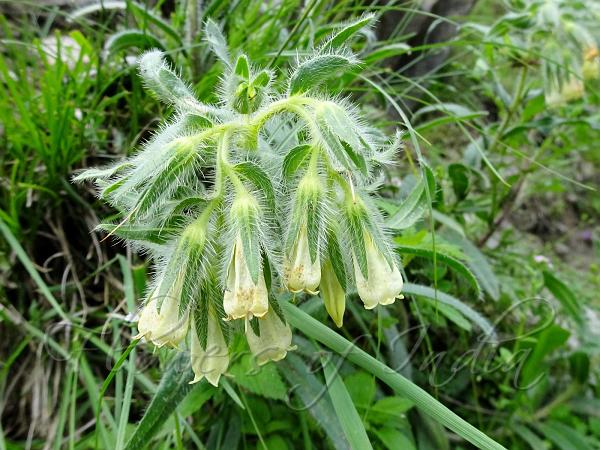|
| Bristly Onosma |
|

|

|
|
|
|
Photo: |
Botanical name: Onosma hispida Family: Boraginaceae (Forget-me-not family)
Bristly Onosma is a perennial herb up to 70 cm tall
with a prominent tap root. Stems are many, mostly simple, hollow,
densely hairy with long spreading hairs 3.5-5 m long. Basal leave are
9-35 cm long, 5-10 mm wide, linear to oblanceolate, middle stem leaves
are often larger uppermost smaller. Inflorescence a terminal cyme,
dense at anthesis, elongating to 12 cm in fruit. Bracts are lanceolate,
leaf-like, but smaller. Flower-stalks are short, densely hairy, up to
10 mm in fruit. Calyx is 1.1-1.3 cm long, up to 2 cm in fruit, densely
hairy, sepals lanceshaped. Flowers are creamish-white to light yellow,
tubular-bell-shaped 2-3 cm long, velvet-hairy outside, petals 1.5-1.8
mm long, deflexed. Style is up to 2 cm long. Nutlets are 5-6 mm long,
shiny. Bristly Onosma is found in the Himalayas, from Afghanistan to
Himachal Pradesh, at altitudes of 1000-4000 m. Flowering: May June.
Medicinal uses: Root yields red color
commercial dye, mainly used for coloring foodstuffs, wools, oils and
medicinal preparations. Also, used in the treatment of wounds, pain
relief, fevers, infectious diseases, bites and stings. Flowers are used
as stimulant and cardiac tonic. Bruised roots of ratanjot are applied
externally to cutaneous eruptions.
Root yields red color
commercial dye, mainly used for coloring foodstuffs, wools, oils and
medicinal preparations. Also, used in the treatment of wounds, pain
relief, fevers, infectious diseases, bites and stings. Flowers are used
as stimulant and cardiac tonic. Bruised roots of ratanjot are applied
externally to cutaneous eruptions.
Medicinal uses:
 Root yields red color
commercial dye, mainly used for coloring foodstuffs, wools, oils and
medicinal preparations. Also, used in the treatment of wounds, pain
relief, fevers, infectious diseases, bites and stings. Flowers are used
as stimulant and cardiac tonic. Bruised roots of ratanjot are applied
externally to cutaneous eruptions.
Root yields red color
commercial dye, mainly used for coloring foodstuffs, wools, oils and
medicinal preparations. Also, used in the treatment of wounds, pain
relief, fevers, infectious diseases, bites and stings. Flowers are used
as stimulant and cardiac tonic. Bruised roots of ratanjot are applied
externally to cutaneous eruptions. | Identification credit: Krishan Lal | Photographed in Kishtwar, Kashmir & Lahaul, Himachal Pradesh. |
• Is this flower misidentified? If yes,